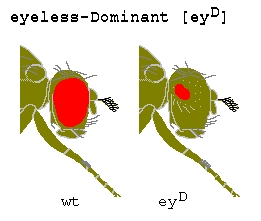

EYELESS-DOMINANT [eyD]
Lindsley & Grell, 1972, p. 90
origin: X ray induced.
discoverer: Muller, 27k.
references: Patterson and Muller, 1930, Genetics 15: 495-577 (fig.). Bridges, 1935, Biol. Zh. (Moscow) 4: 401-20. 1935, Tr. Dinam. Razvit 10: 463-73.
phenotype: Eyes small, outline irregular, displaced toward top and rear. Head large, often with duplicated antennae or ocelli. Sex combs always very large. Second joint of tarsi shortened to give lumps, sometimes very conspicuous. Fully dominant in triplo-4 flies (Sturtevant, 1936, Genetics 21: 448). Eye size of B; eyD/+ males larger than of B alone. Produces extreme phenotype in combination with D. D/+; eyD/+ almost completely lethal (Sobels, Kruijt, and Spronk, 1951, DIS 25: 128). Homozygous lethal. Homozygotes die during larval period and many eyD/+ flies die as pupae (Hochman). RK2.
cytology: Salivary chromosomes show duplication of about a dozen bands inserted into middle of fourth chromosome as a reversed repeat. Source of duplication unknown (Bridges, 1935).
other information: May not be an allele of ey.
color figure: P. A. Otto (original)
b & w figure: Left: head. Right: first pair of legs. Patterson and Muller, 1930, Genetics 15: 495-577.

